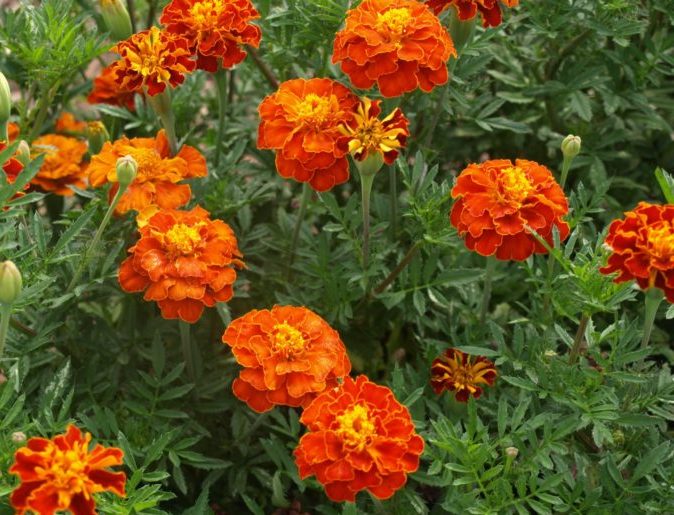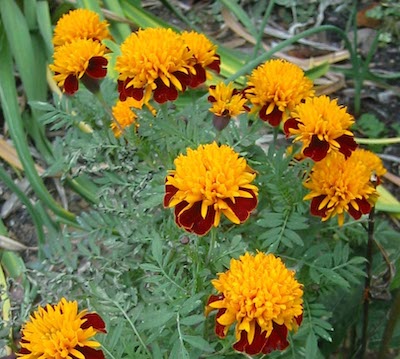Mary’s Gold
By Ray Novitske, Fairfax Master Gardener

French marigolds
The marigold got its name as a shortened version of “Mary’s gold,” named after the Virgin Mary in European medieval times. Marigolds are native to the subtropical Americas, having been cultivated in Mexico for over 2000 years. In the 1500s, explorers took marigold seeds from the Aztecs and brought them back to Spain where they were grown in monastery gardens. Once in Spain, seeds were spread further through trade to Europe, and to Africa where they became naturalized. Today, we have French and African marigolds as different species.
The Aztecs and Mayan cultures revered the flower and often used it to honor the gods and spirits. For the Mexico’s Day of the Dead, orange marigolds play an important part in the holiday celebrations. It is believed that spirits are attracted to the marigold’s spicy scent and the color, so they are often placed on alters and around gravesites to help guide spirits along their paths.

African marigolds
The two species grown in our gardens are the French marigold, Tagetes patula, and the African marigold, Tagetes erecta. French marigolds are compact, flower profusely, and are appropriate for window boxes, containers, and borders in mass plantings. Hybrid French marigolds come in single- or double-flowering cultivars, and can be yellow, orange, dark ruddy red color, or sport a combination. Some French varieties are open-pollinated, meaning their seed will produce plants true to the parents.
African marigolds are more solid yellow or orange, taller, bushier, and can have large blooms up to 4 inches (10 cm) in diameter. Because of their size and 3 to 4 foot tall (1 to 1.2 m) height, they often require support to keep them upright, especially in our summer storms with blustery winds.
A newer species is the signet marigold, Tagetes tenuifolia. These are smaller plants being only 6 inches tall (15 cm) with fuller bushy foliage forming mounded plants. The blooms are more often single, and are similar in color to the French marigolds.

Signet marigolds ‘Tangerine Gem’
Years ago, our country did not have an official flower. The marigold was thought to be a suitable candidate because of its native home in the Americas, but its yellow color was not desirable. A white cultivar was needed for the marigold to be seriously considered, so the call went out to find one. Burpee Seed Company researched and offered a prize to the home gardener who could help find seeds to be used to produce a white marigold. A home gardener in Iowa eventually came through, and as a result, today we have cream and creamy-white French and African marigolds. (The rose ended up being selected as the official U.S. flower.)
Marigolds are considered an annual here, and will bloom throughout the summer and into the late fall until frost. They germinate quickly from seed, making them an easy plant beginners and home gardeners to start themselves. The foliage is attractive, fern-like, and strongly scented, making it unattractive to deer. They prefer full sun and rich well-drained soil, but will grow in poor soils too. They do not need deadheading to continually bloom, but will benefit from it.
Although marigolds are easy to grow and reliably bloom all summer without disease or pests, there are some problems that can attack them. Despite their strong scent and its reputation for repelling pests, some insects are actually attracted to them. Spider mites are a persistent problem in hot weather, especially in dry conditions. Their sucking damage is seen as tiny whiteish dots resembling powder on the leaves. Slugs appreciate them as tasty treats, and aphids, leafminers, whiteflies, and thrips can cause destructive damage.

French marigold “Tiger Eyes’
Marigolds get the strong scent from a chemical they produce called alpha-terthienyl. This has been proven to repel certain types of plant parasitic nematodes by planting them alongside crops to be protected. Some gardeners and garden folklore encourage planting them in vegetable gardens to repel harmful pests. Research however, has shown that marigolds are not effective in reducing insect populations or insect damage on vegetable crops.
I grow the French marigold ‘Tiger Eyes’ as a bushy, low border plant and find that they reseed, coming back themselves year after year. They enjoy our hot summer sun, and are only bothered by spider mites when weather is dry for a prolonged period of time. If you are in need of some cheery yellows and oranges, marigolds can brighten up any garden area in the heat of summer.
References
Marigold, Clemson Cooperative Extension
The special role of marigolds on the Day of the Dead, WUSF Public Media
Marigolds (Tagetes), UIC Heritage Garden
Marigolds, University of Florida Extension
Marigolds, Iowa State University Extension and Outreach
Alice Vonk, Wikipedia